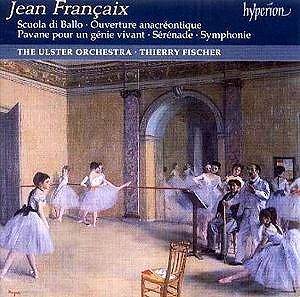Throughout his long composing life Jean Françaix
remained faithful to his own ideals of clarity and elegance. These he
chose to express in his particular brand of Gallic Neo-classicism though
he always managed to inflect it with unexpected rhythmic and harmonic
twists.
The earlier work here, the ballet Scuola di Ballo
(1933, though it might be still earlier than that) is a clear product
of its times when Stravinsky surprised his followers with his iconoclastic
Pulcinella based on themes of Pergolesi and when a number
of composers such as Respighi, Tommasini or (somewhat later) Britten
based ballet scores on older musicians’ music. Françaix’s delightful
ballet, on themes of Boccherini, is piquantly scored for small orchestra,
but it is decidedly light stuff.
I have always retained a real affection for the wonderful
Sérénade of 1934. It was the very first
work by Françaix that I ever heard. I have loved it ever since.
It is a splendid example of its composer’s Neo-classicism "with
a French accent": clear orchestration with a typical liking for
wind instruments, catchy tunes and ideal proportions. Such music never
outstays its welcome.
Jean Françaix composed three symphonies of which
the Second (for string orchestra) is undoubtedly the finest. The present
Symphony in G major, completed in 1953, overtly pays homage
to Haydn, for whom Françaix obviously has a sincere affection.
Françaix’s work is modelled on Haydn’s own symphonies and its
four short movements, of which the third one is a Minuet and Trio, are
full of typical Françaix fingerprints.
The Ouverture anacréontique of
1978 may be one of Françaix’s longest single movements. It opens
with a beautiful slow introduction (one of his finest inventions) leading
into a dancing middle section in turn leading to a restatement of the
introduction capped by a brilliant Coda based on the earlier dance section.
Composed to celebrate the fiftieth anniversary of Ravel’s
death, Pavane pour un Génie vivant inevitably brings
Ravel’s beautiful Pavane pour une Infante Défunte
to mind. (The opening tune of Françaix’s work is almost that
of Ravel’s ... upside down.) A heartfelt homage for all its simplicity,
and a perfect example of what Françaix could achieve with the
simplest means.
Recordings of Françaix’s superbly crafted music
are always a joy, and the present release is no exception. Fine performances
on all counts and a well judged selection of Françaix’s prolific
and varied output, which I unreservedly recommend. I for one hope that
more of Françaix’s refreshing music will soon be recorded by
the same forces.
Hubert Culot


